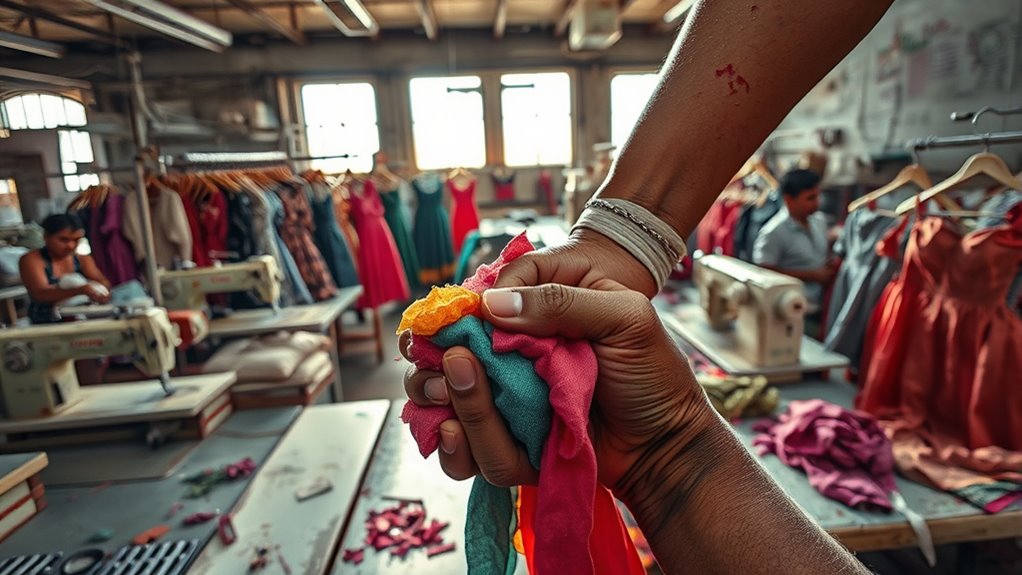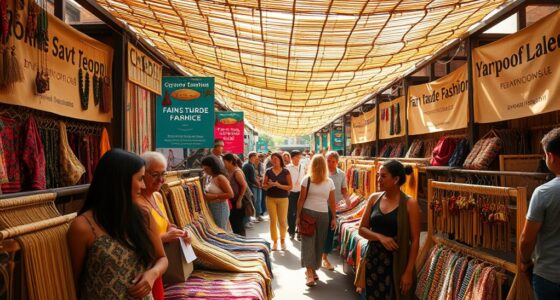A $5 dress hides the dark side of fast fashion, where workers face unsafe conditions, long hours, and unfair wages in countries with lax regulations. Its low price also masks environmental harm, like water pollution and textile waste that damage ecosystems. By purchasing cheaply, you support exploitative practices and environmental degradation. If you keep exploring, you’ll discover how your choices impact the planet and the people who make your clothes—and what you can do about it.
Key Takeaways
- Workers in outsourced factories often face unsafe conditions, long hours, and unfair wages to produce cheap dresses.
- The low price hides environmental damage from synthetic fibers, water pollution, and textile waste.
- Fast fashion brands prioritize cost-cutting over ethical supply chain practices, leading to exploitation.
- Consumers may be unaware that their $5 dress contributes to ecological harm and worker exploitation.
- Supporting ethical and sustainable fashion can help reduce the hidden human and environmental costs.

A $5 dress might seem like a steal, but beneath that low price tag lies a hidden cost that often goes unnoticed. When you pick up that inexpensive garment, you’re not just buying a piece of clothing; you’re also supporting a supply chain that can have serious ethical and environmental consequences. Many fast fashion brands prioritize cost-cutting over supply chain ethics, meaning workers in developing countries often face unsafe conditions, long hours, and unfair wages. These companies frequently outsource production to factories with minimal oversight, making it difficult to hold them accountable for worker treatment. By purchasing such cheap dresses, you inadvertently contribute to a system where labor rights are ignored and exploitation is widespread.
Beyond worker treatment, the environmental impact of producing a $5 dress is equally alarming. Fast fashion garments are typically made from cheap, synthetic fibers that are difficult to recycle and take centuries to decompose. The manufacturing process involves significant water and energy consumption, often in countries with lax environmental regulations. As a result, pollution from dyeing and finishing processes contaminates local water supplies, harming both ecosystems and communities. The production of these garments also generates a large amount of textile waste, much of which ends up in landfills after just a few wears. This cycle of overproduction and disposal fuels environmental degradation and contributes to climate change. environmental impact remains a major concern associated with fast fashion.
When you buy a $5 dress, you’re not only making a quick fashion statement but also endorsing a cycle that prioritizes profit over people and planet. The low price is made possible by cutting corners on ethical practices and environmental safeguards. Fast fashion brands often source materials from countries where environmental regulations are weak, allowing them to dump waste and pollutants without consequence. This creates a ripple effect, harming local communities and ecosystems, and perpetuating a cycle of environmental harm. Many workers involved in producing these garments are unaware of the full impact of their labor, or they face dangerous conditions to meet production quotas.
Choosing to ignore these issues might seem like a small act, but it sustains a system that exploits vulnerable workers and destroys the environment. You have the power to make more informed choices—opting for ethically made clothing or second-hand pieces can help reduce your contribution to this cycle. Recognizing the true cost behind that $5 dress means understanding that cheap prices often come at a steep price for others and the planet. Your purchasing decisions can influence the fashion industry to become more transparent, sustainable, and fair.
Frequently Asked Questions
How Do Low Wages Affect Workers’ Health and Well-Being?
Low wages can seriously impact your mental health and physical well-being. When pay is insufficient, you might feel stressed, anxious, or overwhelmed trying to make ends meet. This stress can lead to physical health issues like fatigue, weakened immunity, or chronic pain. You may also skip essential healthcare or nutritious food, which worsens your overall health. In short, low wages put your well-being at risk, affecting both mind and body.
What Environmental Impacts Are Linked to Cheap Fashion Production?
When you buy cheap fashion, you contribute to environmental issues like textile waste and water pollution. Fast fashion brands often discard excess fabric, adding to landfills, while their production processes pollute water sources with dyes and chemicals. This cycle harms ecosystems and depletes resources. By choosing sustainable options, you can help reduce textile waste and lessen water pollution, making a positive impact on the environment.
Are There Ethical Brands Offering Affordable Clothing Options?
Ever stumble upon affordable clothes that feel right? You’ll be glad to know numerous ethical brands prioritize ethical sourcing and fair labor practices while keeping prices reasonable. These companies openly commit to transparency, ensuring workers are paid fairly and environments are sustainable. By choosing such brands, you support responsible fashion, making a positive impact without breaking the bank. So, yes, you can find stylish, affordable options that align with your values.
How Can Consumers Identify Truly Sustainable and Fair-Trade Dresses?
To identify truly sustainable and fair-trade dresses, you need to look for certification labels like Fair Trade, GOTS, or OEKO-TEX. These labels guarantee the brand meets strict social and environmental standards. Do some research on the brand’s practices and transparency. By choosing products with trusted certification labels, you actively support ethical production and make more conscious purchasing decisions that benefit workers and the planet.
What Policies Could Improve Wages and Conditions for Garment Workers?
To improve wages and conditions for garment workers, policies should enforce living wages, ensuring workers earn enough to support themselves. You can advocate for stricter regulations that prioritize worker safety, like regular inspections and safety standards. Supporting fair-trade certifications and transparency also hold brands accountable. These policies help create a safer, fairer workplace where workers earn enough and their rights are protected, fostering sustainable industry growth.
Conclusion
So, next time you pick up that pretty, inexpensive piece, pause and ponder. Behind the bargain, there’s a burden — broken bodies, blurred boundaries, and bleeding borders. Choosing consciously can create change, compassion, and cost clarity. By demanding fair wages and better working conditions, you become a catalyst for positive change. Remember, your purchase power can promote profit with purpose, pushing toward a more just and justifiable journey from factory to fashion.









